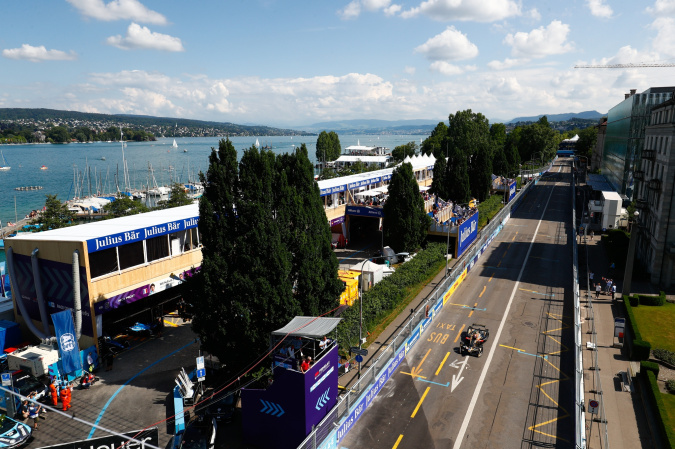Blog entry of 22 May 2025
Formula 1 In Switzerland: Is It Time To Lift The Ban?

Foto: © Formula E / Sam Bloxham
For decades, circuit racing has been absent from Switzerland’s sporting landscape—but is the country finally ready to welcome back motorsport?
The conversation around motorsport in Switzerland is evolving, and the signs suggest a future that may look very different from the past.
The Ban That Froze Swiss Circuit Racing
On 11 June 1955, a disaster unfolded at the 24 Hours of Le Mans. A collision on the main straight sent debris flying into the crowd, killing 83 spectators and driver Pierre Levegh. It remains the deadliest crash in motorsport history and was regarded as a tragedy worldwide. In the aftermath, countries across Europe re-evaluated the safety of racing; most revised their rules, but Switzerland went further. Later that year, the Swiss government enacted a nationwide ban on circuit racing, and for nearly 70 years, it has stayed in place.
While hill climbs and rallying have continued, and motorsport safety has evolved and thrived in the background, the country's circuits remain silent. Even temporary attempts to relax the law, such as the short-lived lifting of the ban for electric car racing in 2015, haven’t rekindled a consistent appetite for change.
Changing Times, Shifting Perceptions
The common justification for the ongoing ban has long been public opinion. Motorsport, it's argued, simply doesn’t reflect the priorities of Swiss society: environmental awareness, neutrality, and restraint. But is that narrative still accurate?
Recent years suggest not entirely. A 2018 Formula E race in Zurich attracted 150,000 spectators and passed without issue. Polling shows a softening stance toward motorsport, especially among younger audiences raised on a digital diet of Formula 1 highlights, video games such as EA Sports F1 25, and popular television shows such as Drive to Survive on Netflix. The cultural tide is shifting—and business isn’t waiting around.
Motorsport Is Already in Switzerland’s Blood
Switzerland may have banned circuit racing, but it has never banned motorsport itself. Sauber Motorsport, one of the most iconic names in Formula 1, has operated out of Hinwil since the 1970s. It began in sports car racing, entered F1 in 1993, and has nurtured legends like Kimi Räikkönen, Sebastian Vettel and Charles Leclerc. Now running under the Stake F1 Team Kick Sauber banner, it represents Switzerland at the pinnacle of global motorsport.
The country is also home to numerous high-tech engineering firms, motorsport consultancies, and the Swiss Racing Academy. While circuits like Silverstone or Monza provide the stage, Swiss minds are often behind the performance. From logistics to simulator training, aerodynamics to telemetry, the Swiss footprint is vast—and growing.
What About the Fans and the Market?
Fans have always driven Formula 1, so to speak. Whether watching on TV or playing video games, Swiss racing enthusiasts have still followed the sport. The games are not banned in Switzerland, and as the digital age envelops us, there are new and interesting ways fans can engage with the sport.
If there's one place that reveals public sentiment unfiltered, it’s the betting market. And here too, motorsport isn’t just tolerated—it’s embraced. Swiss platforms like SportwettenSchweiz.org don’t shy away from motorsport content. On the contrary, they regularly feature race previews, driver insights, and tips to bet on Formula 1. Whether it's Leclerc chasing a podium or Verstappen entering as favourite, Swiss bettors are engaged and informed.
These platforms not only reflect the sporting interests of the nation but also drive dialogue and excitement around events that the country, legally, still can't host. The gap between legislation and lived experience continues to widen, with pop culture and fan interaction as strong as ever.
The Economics of Exclusion
Switzerland’s resistance to circuit racing has had measurable costs. While nearby Austria enjoys the economic windfall of hosting the Red Bull Ring Grand Prix, Swiss towns miss out on the tourism, hospitality, and brand partnerships that come with modern motorsport. This isn’t just about racing—it’s about missed economic opportunity.
Ironically, Swiss businesses are already active players in the F1 market. From watch brands like Rolex sponsoring the FIA, to logistics companies facilitating international race transport, the nation has capitalised on the global motorsport industry, just not within its borders.
There have been attempts to lift the ban. In 2018, following the Zurich E-Prix, proposals were floated to open discussions about a permanent return of circuit racing. Though political will remains mixed, the conversation is alive, and pressure from various quarters—economic, cultural, and sporting—is building.
Conclusion: A Nation at the Crossroads
Motorsport in Switzerland is not dead—it never was. It lives in the garages of Hinwil, the classrooms of the Swiss Racing Academy, the watchlists of Formula 1 fans, fans playing EA Sports F1 25 and yes, even in the betting odds available from Zurich to Geneva. The only thing it lacks is a home circuit, a Swiss Grand Prix to light the touchpaper.
Motorsport has changed since 1955. Safety standards are radically improved, public engagement is smarter and broader, and the environmental footprint of racing is shrinking thanks to electric and hybrid categories. The sport no longer resembles the gas-fuelled chaos that led to Switzerland’s ban—and perhaps it’s time the laws reflected that.
If public opinion continues to soften and policymakers choose pragmatism over nostalgia, Switzerland could yet carve out a new place in motorsport’s future. The question is not just will motorsport return, but when, and on what terms.

